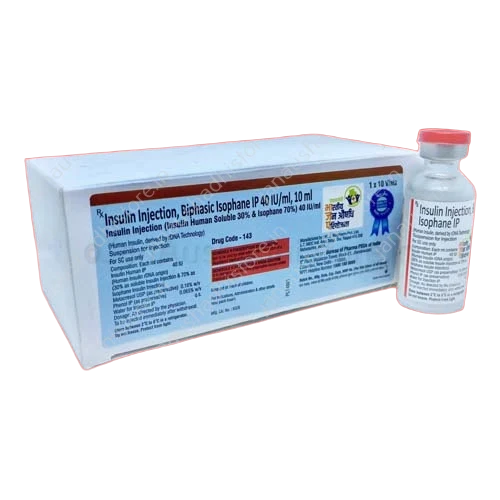
143 Insulin Injection IP 40 IU per ml (Insulin Human Soluble 30% and Isophane 70%)
Dual Action Insulin Therapy
₹90.01
Code-143 Insulin Injection IP 40 IU/ml, from PMBI, Govt of India, is a biphasic insulin formulation combining 30% short-acting insulin human soluble and 70% intermediate-acting insulin isophane to provide both rapid and prolonged blood sugar control in diabetes treatment.
Composition and Mechanism
This insulin injection contains 40 IU of insulin per ml, composed of 30% soluble (fast-acting) human insulin and 70% isophane (NPH, intermediate-acting) insulin designed for a dual-action effect.
The soluble insulin provides a rapid onset of action, usually within 30 minutes, peaking around 1.5 to 2.5 hours, while isophane insulin has a slower onset (1–2 hours), peaks at 4–8 hours, and lasts up to 24 hours.
It works by facilitating glucose uptake into muscle and fat cells and suppressing hepatic glucose production, thereby lowering blood sugar levels effectively over both short and intermediate durations
.
Indications and Usage
Used in type 1 and type 2 diabetes mellitus for improving glycemic control when oral medications alone are insufficient.
The biphasic nature supports control of both post-meal glucose spikes (via soluble insulin) and basal glucose levels (via isophane insulin).
Typically injected subcutaneously in the abdomen, thigh, upper arm, or buttocks. The abdominal area may lead to faster absorption.
Injection should be administered about 15 minutes before or within 20-30 minutes of the start of a meal to optimize efficacy and prevent hypoglycemia
.
Dosage and Administration
Dose individualization is critical and dependent on patient metabolism, weight, diet, activity, and glucose monitoring.
Premixed insulin is generally given once or twice daily based on patient requirements.
Patients should be trained on injection technique, including ensuring the insulin is uniformly resuspended (cloudy appearance) by gentle rolling before drawing up the dose.
Rotate injection sites within the same anatomical region to avoid lipodystrophy (skin thickening or lumps)
.
Side Effects and Precautions
Most common side effect: Hypoglycemia (low blood sugar). Symptoms include dizziness, sweating, confusion, and headache; immediate intake of glucose is necessary if hypoglycemia occurs.
Local reactions at injection sites such as pain, redness, swelling, itching, or lipodystrophy may happen.
Other possible effects: weight gain, edema (fluid retention), rash, and allergic reactions in rare cases.
Alcohol consumption is discouraged during treatment as it can unpredictably lower blood sugar levels and increase hypoglycemia risk.
Special caution is advised in patients with kidney, liver, or heart diseases; dosage adjustments may be needed
.
Storage and Handling
Store unopened vials in a refrigerator at 2°C to 8°C (35.6°F - 46.4°F); do not freeze.
Once opened, vials can be kept at room temperature (not exceeding 25°C) and used within 4 weeks.
Protect from direct sunlight and extreme heat.
Use a new sterile needle and syringe for each injection to avoid contamination
.
Additional Advice
Regular blood glucose monitoring is essential to optimize dosing and prevent complications.
Follow a healthy diet, maintain physical activity, and adhere to insulin schedules as prescribed.
Never share insulin pens or syringes with others.
Consult your healthcare provider immediately if you experience unusual symptoms or if you plan to change insulin brands or dosage.
Pregnant or breastfeeding women should seek specific medical advice; insulin is often considered safe but dose adjustments may be necessary
© 2025. All rights reserved by Ross & Fleming India Super-specialty Clinics